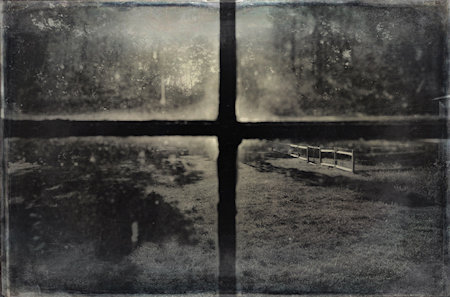In those falling years, we hiked often to one cabin or another, all crumbling into ruin. We’d eat our lunch with legs dangling out an empty window frame. I always liked when we could open a closet and see the bright bird and flower wallpaper that had once decorated all of these gray and yellowing walls.
I try not to be afraid to say what is real. I try not to hide behind the convenient narrative. You could say we fell in love, but it would be more precise to say I followed him through one door in the woods to another.
There was one place, reduced to a square of foundation and a chimney, surrounded by 10,000 daffodils, their faces following the sun as it passed from the cabin over the path and down again to the creek. The wind blew through them, and it was hard not to think that for a moment I saw the glimmer of a woman in a polka dot dress kneeling in the grass with a trowel in her hand, a basket of bulbs by her side.
When I’m afraid all I have is hurt, that I ruin everything if I stay too long, I think about her.
A few years back the cabins were all burned down by the local forest service rangers, and I have grieved them, as I do the pallid sturgeon, the hellbender, the nimble wills, the wake robins, the ebonyshell and sheepnose mussels, all gone from this place.
If I were to bet, I’d say they were guys with badges who liked the feeling of setting a fire. Or the world is terrifying so they cling to a narrow definition of order. Or maybe they just don’t imagine much at all. They said the cabins were being used to cook meth, so maybe they saw something awful and burning down abandoned houses on overgrown homesteads in a forgotten county of a failing state made it seem like they’d done what they could to help.
Susan Stewart wrote a philosophical treatise on ruins and one of her theories was that a ruin’s emotional impact occurs in direct proportion to the permanence of its materials. This theory does not account for how it delighted me to come upon a splintered one room cabin, maple tree growing through the last slats of roof with a vulture taloned to the shingled hip like a heartbeat ready to leap.
When he proposed to me at the top of a ruined fortress carved with impressive permanence from the side of a mountain, I found the wreckage unimpressive—just stones and dust and sun. But later that day we wandered in the woods at the base of the mountain. These were young trees reclaiming the geometry of what had been a wheat field. A glint of metal caught his eye, and he reached into the leaf litter to lift out a scythe. It was flaking chunks of rust, but its heft and moon shape were nice and also it seemed to remember the grass in a way we might come to remember each other.
Stewart does say some things about ruins that ring true: “In a ruin, a formerly closed view will be opened to weather, light, earth, and sky, and our awareness of what was once present will be more acute because of its absence.”
Somewhere the sky is orange on fire. Here, between the pile of stones where a great-grandfather was born and the trickle of a wet weather creek, it is only a thin gray. So I lean my head on his shoulder, feeling what we’ve lost and also what of us remains. I wouldn’t have it otherwise, of course. Because we couldn’t. Because it’s futile to hold anything against time. Because of the swallows and pipistrelles, barn owls and house martins who prefer our buckled eaves and crumbling chimneys to nest. Who flourish in our wreckage.
___
Kathryn Nuernberger’s latest book is The Witch of Eye, which is about witches and witch trials. She is also the author of the poetry collections, RUE, The End of Pink and Rag & Bone, as well as a collection of lyric essays, Brief Interviews with the Romantic Past. Her awards include the James Laughlin Prize from the Academy of American Poets, an NEA fellowship, and notable essays in the Best American series. She teaches poetry and nonfiction for the MFA program at University of Minnesota.


3 comments
Chris Richards says:
Sep 20, 2021
Love this. Beautiful.
Jake Rathbun says:
Sep 23, 2021
I think the story was beautiful. I also thought that it had an element of acceptance, through the story details (which were beautifully crafted by the way) I got a feeling that the love was symbolized by the trees and the past was symbolized by the ruins. Those details tell a message that even though the past left us ruined love will prevail over it and all of the fear.
Sierra Miller says:
Jan 7, 2022
I think the imagery you used was amazing. I was able to picture some of the cabins, and I could feel how your environment contributed to the love you felt. I enjoyed reading about this beautiful experience.